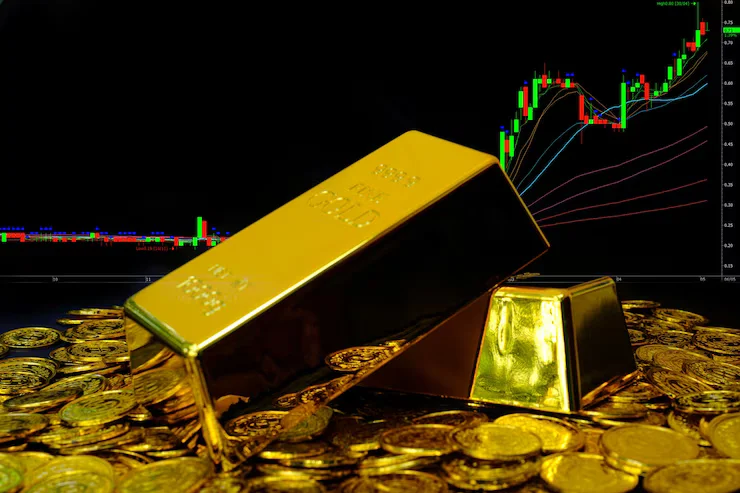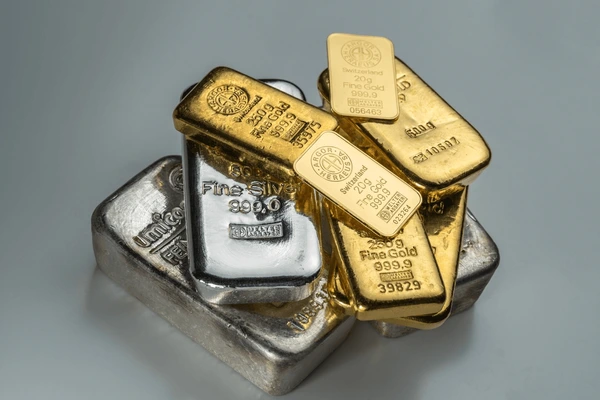Sayanava Sinha Roy
19.02.2025
Why do Gold Prices Fluctuate? Key Factors You Should Know
Gold price fluctuation factors include inflation, currency value, and market demand. A renowned gold buyer understands these shifts—learn why gold prices change and how to invest wisely.
Gold has been a valuable asset for centuries, serving as a hedge against inflation, a symbol of wealth, and a preferred investment during uncertain times. However, if you track gold prices, you’ll notice that they never stay the same for long.
This fluctuation in gold prices is influenced by various gold price fluctuation factors, including global economic conditions, currency value, interest rates, and geopolitical events. Understanding these factors is essential for investors, traders, and buyers who want to make informed decisions in the gold market.
Table of Contents
In this article, we will explore the key reasons behind gold price fluctuations and how you can use this knowledge to your advantage.

The Fundamentals of Gold Price Fluctuation
Unlike other commodities, gold is not just an industrial metal—it holds significant economic and financial importance. While some factors influence gold in the short term, others shape its long-term value.
For instance, during a financial crisis, gold prices usually rise because investors see it as a safe-haven asset. Similarly, when the economy is stable, gold prices may decline as investors turn to higher-yield investments like stocks.
Understanding the gold price fluctuation factors can help you predict when prices are likely to rise or fall. Let’s explore these in detail.
Key Factors Influencing Gold Price Fluctuations
1. Demand and Supply: The Basic Market Rule
Like any commodity, gold prices are dictated by the forces of demand and supply.
- When demand for gold increases and supply is limited, prices rise.
- When demand decreases or supply exceeds market needs, prices drop.
Some of the major factors affecting gold demand and supply include:
✅ Festive and Wedding Seasons – In countries like India, gold demand surges during festivals and wedding seasons, driving prices higher.
✅ Jewelry and Industrial Use – Gold is widely used in jewelry and electronics, influencing demand trends.
✅ Gold Mining and Production – If mining output drops due to higher extraction costs or regulatory restrictions, supply reduces, pushing prices up.
2. Inflation and Gold: A Strong Correlation
One of the most well-known gold price fluctuation factors is inflation.
💰 Why? Inflation decreases the purchasing power of currency, leading investors to seek gold as a stable store of value.
- When inflation is high, gold prices rise.
- When inflation is under control, gold prices may stabilize or decline.
Historically, gold has been a hedge against inflation because it retains its value even when fiat currency weakens.
3. Currency Exchange Rates and the US Dollar
Gold is globally traded in US dollars. This means its price is inversely related to the strength of the dollar.
- A strong US dollar makes gold expensive for foreign buyers, reducing demand and lowering prices.
- A weak US dollar makes gold cheaper, increasing demand and driving prices up.
For example, if the dollar weakens due to economic uncertainty, central banks and investors move towards gold, increasing its price.
4. Central Bank Policies and Interest Rates
Monetary policies set by central banks influence gold price fluctuation factors significantly.
📉 Rising Interest Rates – When interest rates increase, traditional investments (like fixed deposits and bonds) become more attractive, reducing gold demand.
📈 Falling Interest Rates – When rates drop, investors turn to gold, raising prices.
Central banks also hold gold reserves, and when they buy or sell large quantities, it directly impacts gold prices in the market.
5. Economic and Geopolitical Uncertainty
Gold is often referred to as a “crisis commodity” because its price rises during times of economic and political uncertainty.
Global events that trigger gold price fluctuations include:
🔹 Recessions and Economic Slowdowns – Investors shift towards gold when markets crash or economic growth slows.
🔹 Political Instability – Wars, conflicts, or trade tensions push gold prices up.
🔹 Pandemics and Natural Disasters – Events like COVID-19 led to a sharp rise in gold prices due to market uncertainty.
In short, whenever there is instability in global markets, gold prices tend to increase as investors look for safer alternatives.
6. Gold Mining and Production Costs
The process of mining gold is expensive and labor-intensive. If the cost of gold extraction rises, it directly impacts gold prices.
Factors affecting production costs include:
✅ Labor Costs – Higher wages increase mining expenses.
✅ Energy Prices – Since mining requires fuel and electricity, a rise in energy prices can increase gold production costs.
✅ Government Regulations – Environmental and safety regulations can add additional costs to gold mining operations.
If mining companies reduce production due to high costs, gold supply decreases, leading to higher market prices.
7. Speculation and Market Sentiment
Gold prices are also affected by market speculation.
Traders and investors buy gold based on:
🔹 Future price predictions – If investors believe gold prices will rise, they buy more, pushing prices up.
🔹 ETF (Exchange-Traded Fund) Holdings – Gold-backed ETFs influence demand, affecting prices.
🔹 Stock Market Performance – When stock markets decline, investors turn to gold, increasing its value.
Large-scale purchases or sell-offs by institutional investors can also lead to sudden fluctuations in gold prices.
How to Stay Informed About Gold Price Changes
If you are planning to invest in gold or sell your existing holdings, staying informed about market trends is crucial.
Here’s how you can track gold prices effectively:
📌 Follow global financial news to stay updated on economic trends.
📌 Monitor the US dollar’s strength as it directly affects gold prices.
📌 Observe central bank policies on interest rates and gold reserves.
📌 Keep an eye on geopolitical developments that may impact the global economy.
By doing this, you can make better financial decisions and avoid losses due to unexpected gold price movements.
Looking for a Trusted Gold Buyer?
Gold price fluctuations can impact your returns, so choosing a trusted gold buyer is essential when buying or selling gold.
A reputed name in the gold industry, offering:
✔️ Competitive rates based on real-time gold prices.
✔️ Transparent and professional transactions.
✔️ Expert guidance on gold investments.
Whether you’re an investor or a seller, partnering with a reliable gold buyer ensures that you get the best value for your gold.

Frequently Asked Questions (FAQs) Regarding Gold Price Fluctuation Factors
1. Why do gold prices change daily?
Gold prices fluctuate due to changes in supply and demand, currency exchange rates, interest rates, and geopolitical events.
2. Does inflation always increase gold prices?
Not always, but generally, higher inflation leads to rising gold prices as people turn to gold as a hedge against currency devaluation.
3. Is gold a good investment during a recession?
Yes, gold is considered a safe-haven asset and tends to perform well during economic downturns.
4. How do central banks influence gold prices?
When central banks buy gold, demand increases, pushing prices up. If they sell large quantities, prices may drop.
5. How can I track gold prices in real-time?
You can track prices through financial news websites, gold market apps, or consulting trusted gold buyers.
Gold Price Fluctuations: Know the Factors & Maximize Your Returns
Gold prices are influenced by various gold price fluctuation factors, including inflation, interest rates, currency values, and global events. Understanding these factors helps buyers and investors make well-informed decisions.
By staying updated on gold price trends and choosing the best gold buyer in Kolkata, you can ensure the best returns on your gold investments.
Whether you’re buying, selling, or investing in gold, keeping an eye on market trends will always help you make the right choice.
Popular Post



